Faculty and staff can help paint mural this week

The Wayne State University School of Medicine’s Office of Faculty Affairs and Professional Development has partnered with the WSU Arts Department in the College of Fine, Performing and Communication Arts to design a mural to be installed outside Scott Hall in June.
Any School of Medicine faculty or staff member interested in volunteering to assist painting the mural this week can contact Cara Young at 678-294-4543 or caramarieyoungart@gmail.com.
The mural, the product of a public humanities initiative to connect a multidisciplinary team of physicians, artists, students and local activists with the broader community to celebrate the history of diversity in medicine and public health at Wayne State University and in the city, will be installed on the 375-foot-long public-facing concrete wall along the sidewalk north of Scott Hall, on the south side of Canfield Street.
Wayne State University fine arts students designed the mural, based on the oral histories of community members with deep roots to the location on which the School of Medicine sits. The area is the former site of the Plymouth Congregational Church in Detroit’s historic Black Bottom and Paradise Valley neighborhoods. The mural is intended as a monument to African American progress in the medical field, in Detroit and within the global community.
In 2019, Painting and Drawing Professor Margi Weir had a vision for a mural painting course. She shared that vision with department Chair Sheryl Oring, and students have been making – and capturing – history since then.
“It is important for the Art and Art History Department to have a mural painting class in the curriculum, because a mural is a bridge from our department to other parts of the university, and to the greater Detroit community beyond our campus,” Weir said, “reminding the university and community of the creative work done in the Art and Art History Department, and helping students to look beyond the studio for inspiration and connection.”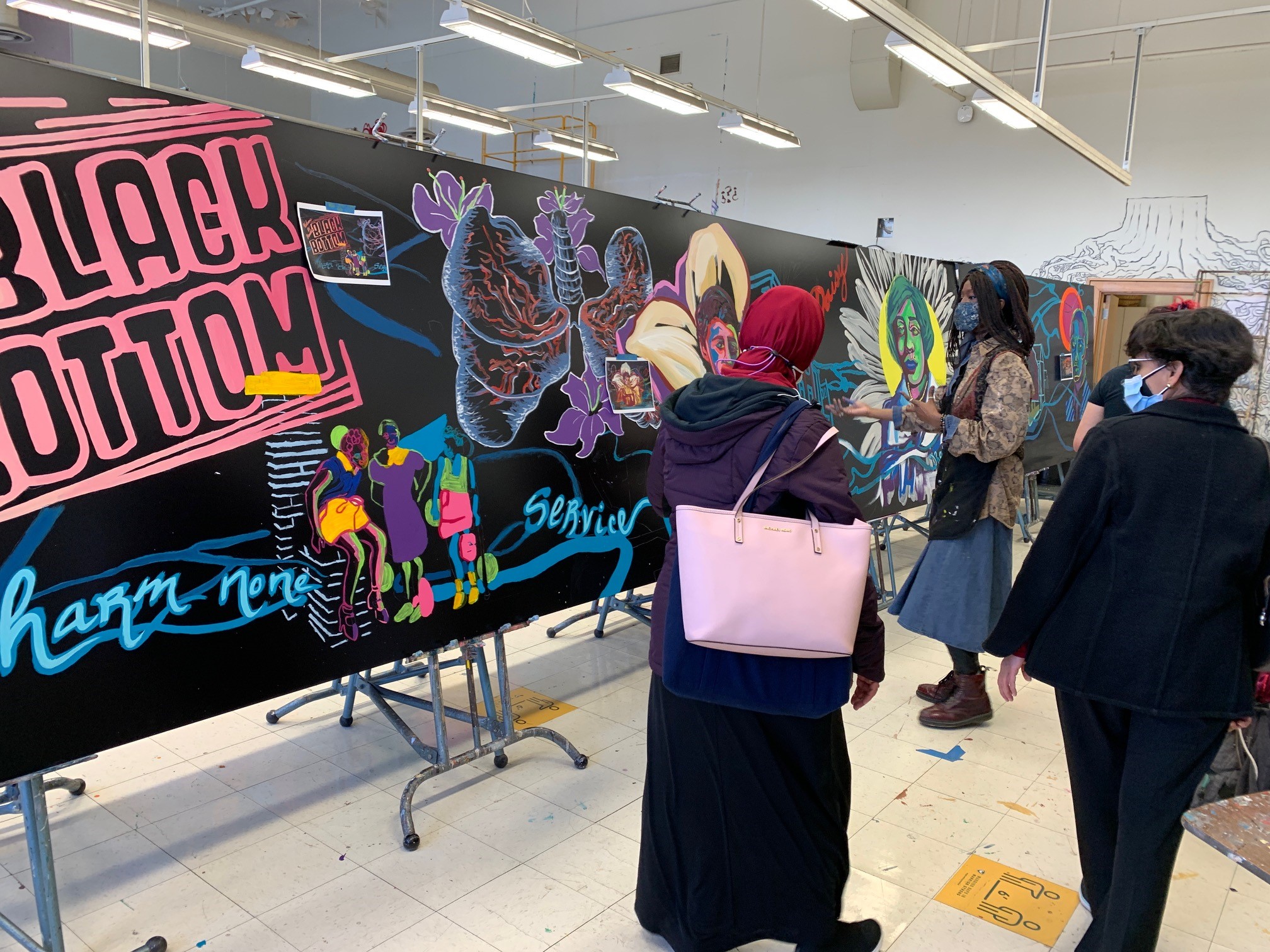
Before a mural painting class was formally offered, a group of seven students used a directed study course in 2019 to partner with Lyft in creating a mural titled “A City Celebration.” In December 2019, the inaugural group of students in the directed study course unveiled a mural for the west side of the WSU Press building between Cass and Woodward on Hancock.
“Reaching consensus about a design and doing it all before the snow fell was a challenge, and the students were great. They were up on scaffolding around Nov. 1 and were out there on Thanksgiving weekend to have the mural done in time. It was completed by force of will,” Weir said.
The course has evolved in exciting directions to bring about greater interdisciplinarity and community impact. There is now a collaborative working group called the Arts Integration in Medical Education, spearheaded by Oring, chair of the James Pearson Duffy Department of Art and Art History; Beena Sood, M.D., associate dean for Professional Development at the School of Medicine; and Grace Serra, WSU Art Collection curator. “We have gathered an incredible group of active collaborators on this project, which demonstrates just how integral it is to addressing some of the most important issues of the day,” Oring said. “Art can play a critical role in helping us see things in new ways, hone observation skills and provide a means of healing.”
Cara Young and Ephemera Fae, master’s of fine arts students in the Art and Art History Department, and Ashley Kramer, an M.D/Ph.D. student at the School of Medicine, are involved in the planning and executing of the mural, and also running workshops with a cohort of medical students on visual thinking strategies, gesture drawing and gross anatomy drawing.
“In the gesture drawing workshops, gross anatomy students are sketching the human figure as they learn human anatomy,” Young said. “This is just a means of them learning their textbook in a different way. It’s a creative outlet that reinforces what they are learning scientifically.”
In addition to these efforts, Jennifer Mendez, Ph.D., associate professor emeritus, Internal Medicine and director of Community Engagement Programs, spearheaded a multidisciplinary research study that was funded by the Association of American Medical Colleges. The study includes Fae and Young who, utilizing art from the WSU Art Collection, have facilitated visual thinking strategy sessions to train medical students to develop more acute visual literacy. This visual literacy training will help medical students in a range of areas, including better interpretation of ultrasound images and developing implicit bias awareness when assessing patients.
The collaboration goes much deeper than the mural, Fae said. “We are trying to build an internal infrastructure that will benefit both colleges in the future so that this becomes an ongoing working relationship that lives past this one mural project. The mural project and the gross anatomy workshops are the first things we're doing, but these are just parts of creating this bigger picture.”
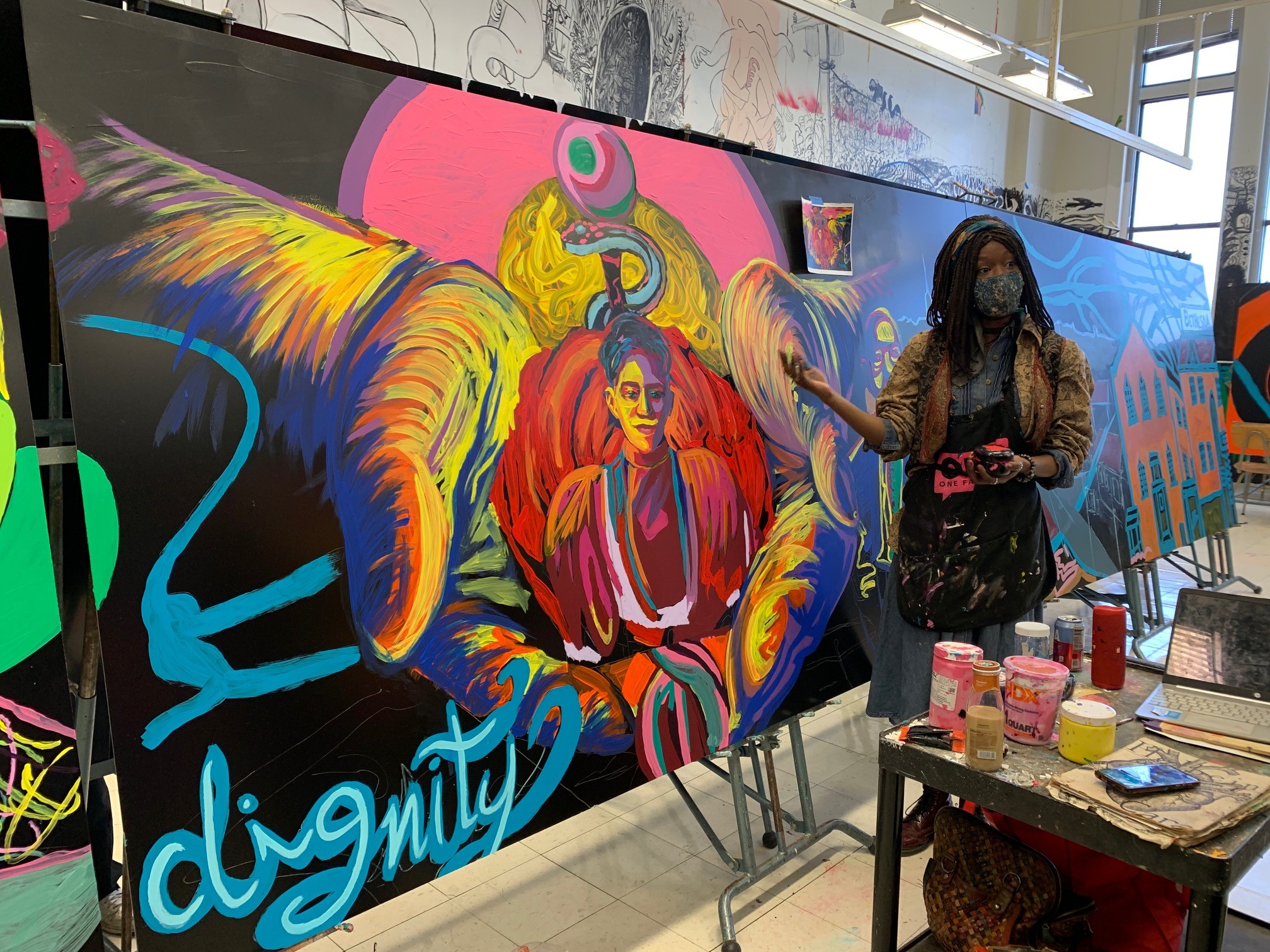 “There are so many multifaceted parts to this. We are building a bridge with the School of Medical but also with the community of Detroit,” Young said.
“There are so many multifaceted parts to this. We are building a bridge with the School of Medical but also with the community of Detroit,” Young said.
While she chaired the Women in Medicine and Science group, Dr. Sood facilitated a journal club organized by the American Medical Women’s Association. The club discussed an article in the Journal of the American Medical Association titled “Deck the Halls with Diverse Portraits,” which analyzed how murals in medical schools tended to promote racial stereotypes and implicit bias. It argued for the need to display diverse teams in schools of medicine and academic health centers.
“That article left a deep impact on me,” she said. “Those of us in the journal club thought that it would be great to have a mural in our school that displayed the true diversity of our profession.”
Dr. Sood was able to bring these ideas forward with the collaboration with Oring, Serra and the Art and Art History Department.
“A little bit of serendipity was involved. I had recently read about an initiative launched by the American Association for Medical Schools called FRAHME that is a toolkit for incorporating arts and humanities into medical education (https://www.aamc.org/what-we-do/mission-areas/medical-education/frahme). From there, I surveyed the faculty in the medical school about Arts in Medicine and the response has been astounding – there is tremendous interest,” she said.
Soon after, Dr. Sood learned that the College of Fine, Performing and Communication Arts and the Art and Art History Department were looking to collaborate with the School of Medicine.
“From there, I connected with Sheryl Oring, and we were able to lay the foundation for a great collaboration. I also learned about the Art in Medicine student organization and immediately started connecting with students,” she added.
The mural is supported by a grant from the Michigan Humanities Council. It will honor the history of diversity in medicine and the impact of African-American health care leaders throughout the history of Detroit and today. The mural also celebrates the role of the Wayne State University School of Medicine and the Detroit Medical Center in shaping health care and public health locally and nationally.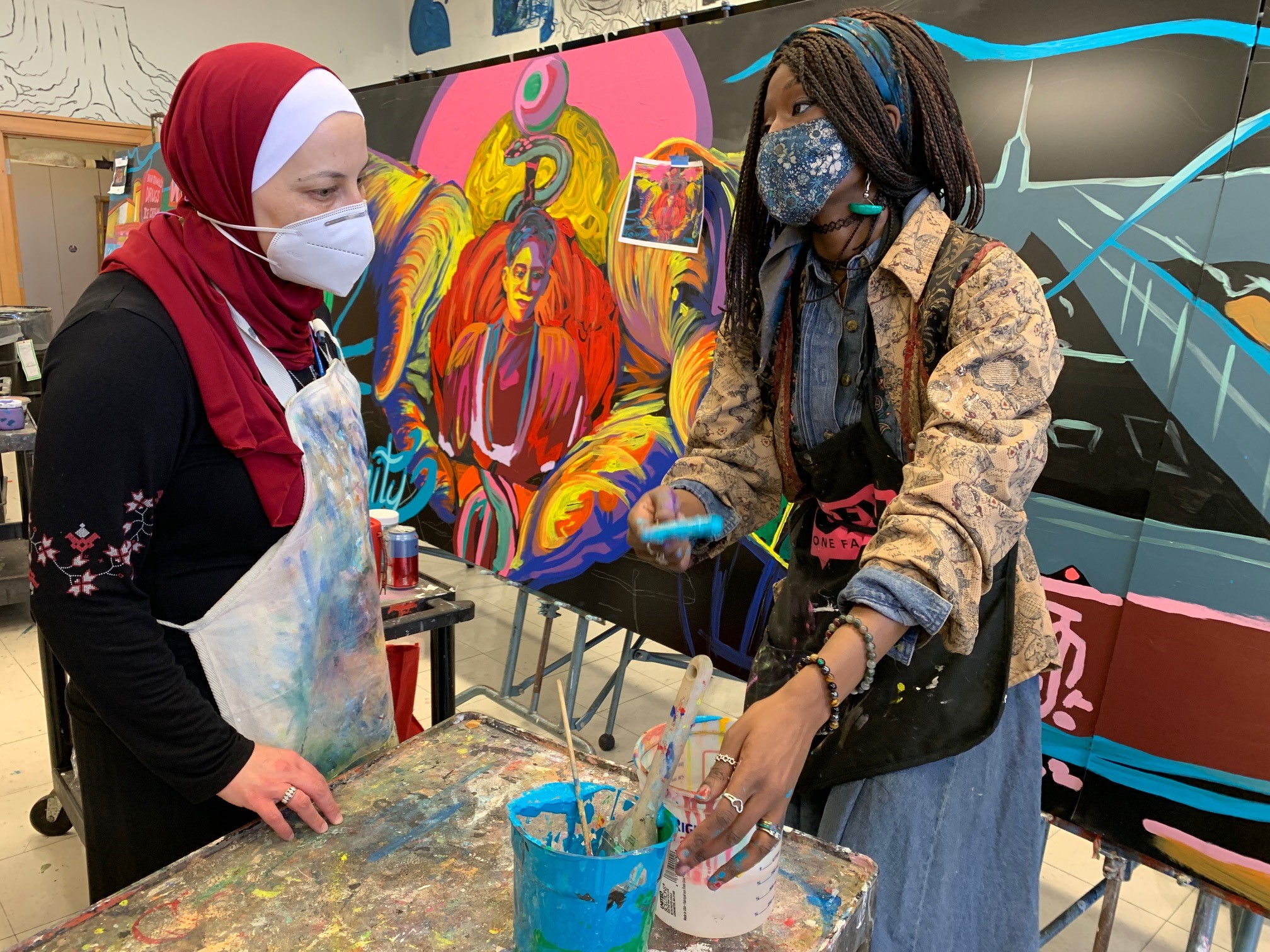
“When we approached the Michigan Humanities Council with our grant proposal,” Serra said, “we were thinking about the impact that the medical school has had on the community, the history of training medical students of color, and how that has impacted the health and well-being of the city. Given the history that WSU has played, the council found our project to be a good fit.”
The intent of the mural and its location provides a forum for a civic dialogue to help build trust between diverse community members and create a beautiful, welcoming community space. “Our hopes are that this will reveal the important symbiotic relationship between the university and the broader community, and use it to serve as a bridge to creating a better future,” Serra said. “Art is the necessary tool to tell these stories.”
Community participation has been a critical part of the project, and it has been emphasized by all of the collaborators.
“We knew that we needed to have community involvement in this project, and it was essential to include their voices,” Dr. Sood said. “We want to break down any walls between Wayne State University’s School of Medicine and the people we serve, and this project can be a means to make that connection.”
Serra conducted oral history interviews while Young and Fae held listening sessions with medical students to help develop the mural concept.
“As we reach out and talk to the community, they can see their stories and their concerns reflected in the product that we produce, and as a way to validate how the community and the artists have come together,” Weir said.
To kick off the project, Serra worked with community leaders Rev. Jimmy Womack and Rev. Nicholas Hood of Plymouth United Church of Christ on St. Antoine Street to connect with congregation members and conduct the oral history interviews. The church, situated around the corner from the School of Medicine, has strong historic ties to Dunbar Hospital. Built in 1892, Dunbar was the first hospital for the Black community in Detroit. At that time, “Black physicians could not practice, and Black patients would not be admitted, to white hospitals. A strong community built up connected to Black Bottom and Paradise Valley, which was right around the corner from Paradise Theater and the Gotham Hotel. These were all very important and famous sites,” Serra said.
One oral history participant is a descendent of Daisy Hill Northcross, M.D., a key figure in Detroit’s history of medicine. Dr. Northcross, the second Black woman to apply for a medical license in Alabama, migrated from Montgomery to Detroit in 1916. The following year, she and her husband, David Northcross, opened the city’s first Black-owned and -operated hospital, Detroit Mercy General Hospital, which paved the way for Dunbar Hospital, where many eminent African-American physicians would get their start. The Northcrosses also opened a nurses training center, a hotel and a store. Dr. Daisy Northcross will be commemorated in the mural through a floral motif pattern.
Fae said the mural will celebrate both the people of Black Bottom who lived in the location of the School of Medicine as well as the ongoing impact of Detroit’s medical community. “It’s the people who are going to be highlighted in the mural,” she said.
“We want to remember that this is a place that was connected to Black Bottom,” Young said. “We also want to honor and celebrate communities that have been marginalized and remember that history as well – not in a way that’s painful, but in a way that celebrates Detroit and the all-encompassing parts of that history.”
Serra stressed the significance of communicating this history through projects like the mural.
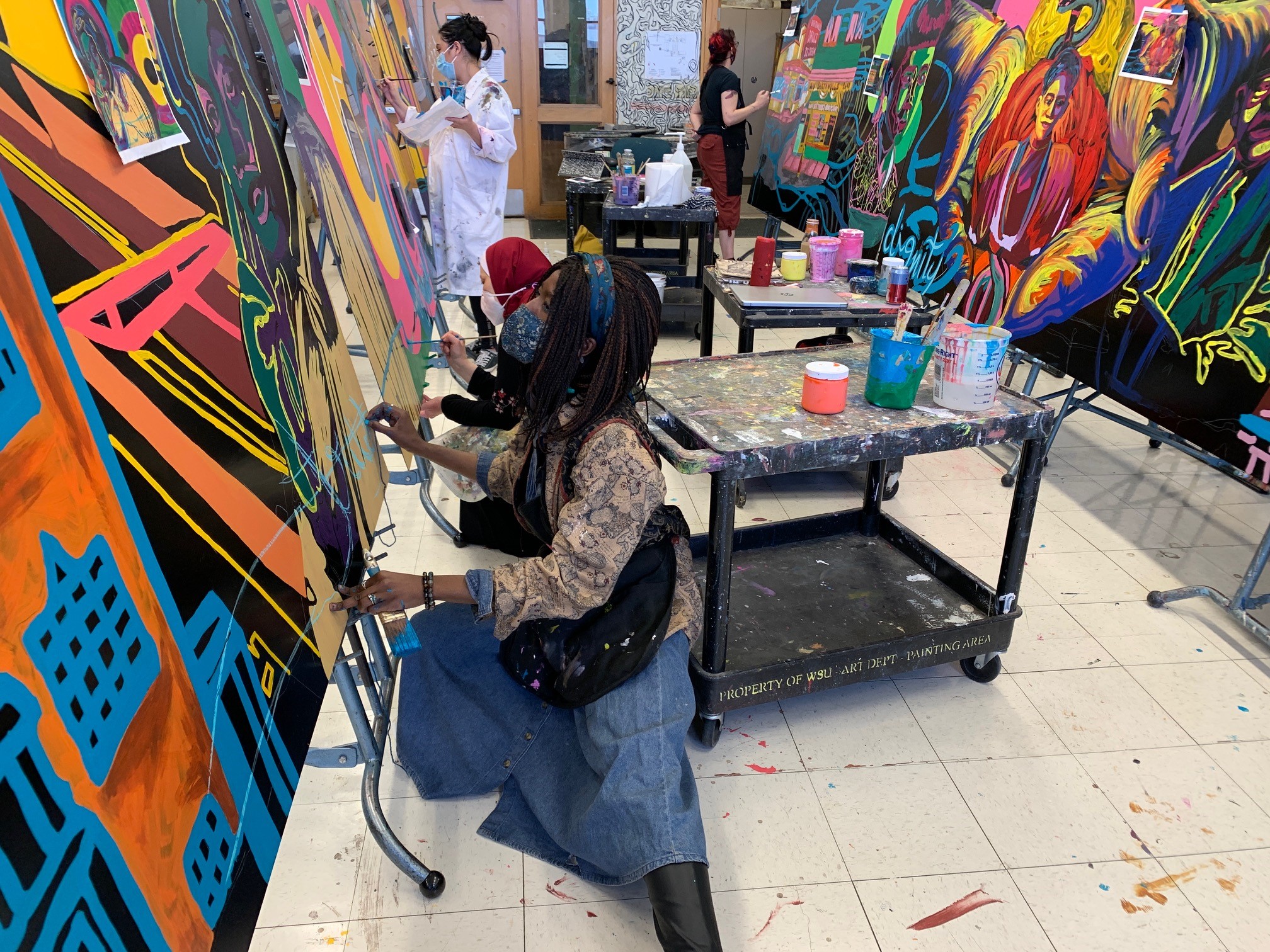 “If we are talking about the history of the medical school and how the medical school had engaged in the community,” she said, “we have to emphasize that there were things that were there before the DMC and the WSU School of Medicine. We need to communicate to the students and to everyone the impact of this vibrant community. In doing the interviews, I found that it was invaluable for the community members to tell their stories. This is a legacy. They realize that they are the ones who remember those times and that at some point there won’t be anyone alive who lived during those times. The idea that young people who weren’t even born during that time will be hearing these stories firsthand is really important and valuable.”
“If we are talking about the history of the medical school and how the medical school had engaged in the community,” she said, “we have to emphasize that there were things that were there before the DMC and the WSU School of Medicine. We need to communicate to the students and to everyone the impact of this vibrant community. In doing the interviews, I found that it was invaluable for the community members to tell their stories. This is a legacy. They realize that they are the ones who remember those times and that at some point there won’t be anyone alive who lived during those times. The idea that young people who weren’t even born during that time will be hearing these stories firsthand is really important and valuable.”
Fae also recognizes the impact of capturing these stories for current and future generations. “We are trying to build an understanding and awareness through these images and symbols. People’s stories don't have to get left behind. We can keep their stories moving. We're trying to show that the history is with us and it is as important as the present.”
The partners agreed that the process of creating a mural has many benefits to students, especially when it comes to working in teams.
“The entire mural design process allowed the students to flourish as a result of their commitment to teamwork and their desire to bring their vision to life,” Oring said.
Working as a team has also been a tremendous growth experience for many art students who may be more used to working alone. “Collaborative art making is new to many of the students in the class,” Weir said. “It can be intimidating at first, but by the end, they are always very engaged.”
Helping students understand the complexities of the public art process is fundamental, Young said. “It is not just one drawing and we're done. It is a whole process that starts with a proposal, a committee, securing the rights to work on a property, creating a budget, constructing the artwork and effectively communicating the message. This is about showing students that public art making is not as simple as picking up the paintbrush and making contact with the surface. There are legalities and social implications for making art in a city like Detroit that can be very complex.”
Fae and Young have taken special care to ensure that the art students involved all have a voice and a role in the creative process. “As a team, we influence each other and we share the work,” Fae said. “One person might come up with the design, and then another person might be translating it to a digital drawing. Color choices may be made by others. Some people’s ideas may win out, but those decisions are made together through discussion.”
Young added that, “Working with the students, there is a lot of encouragement that needs to come in — reminding the students that this is all our project. It takes all of our minds working together. It’s really quite incredible.”
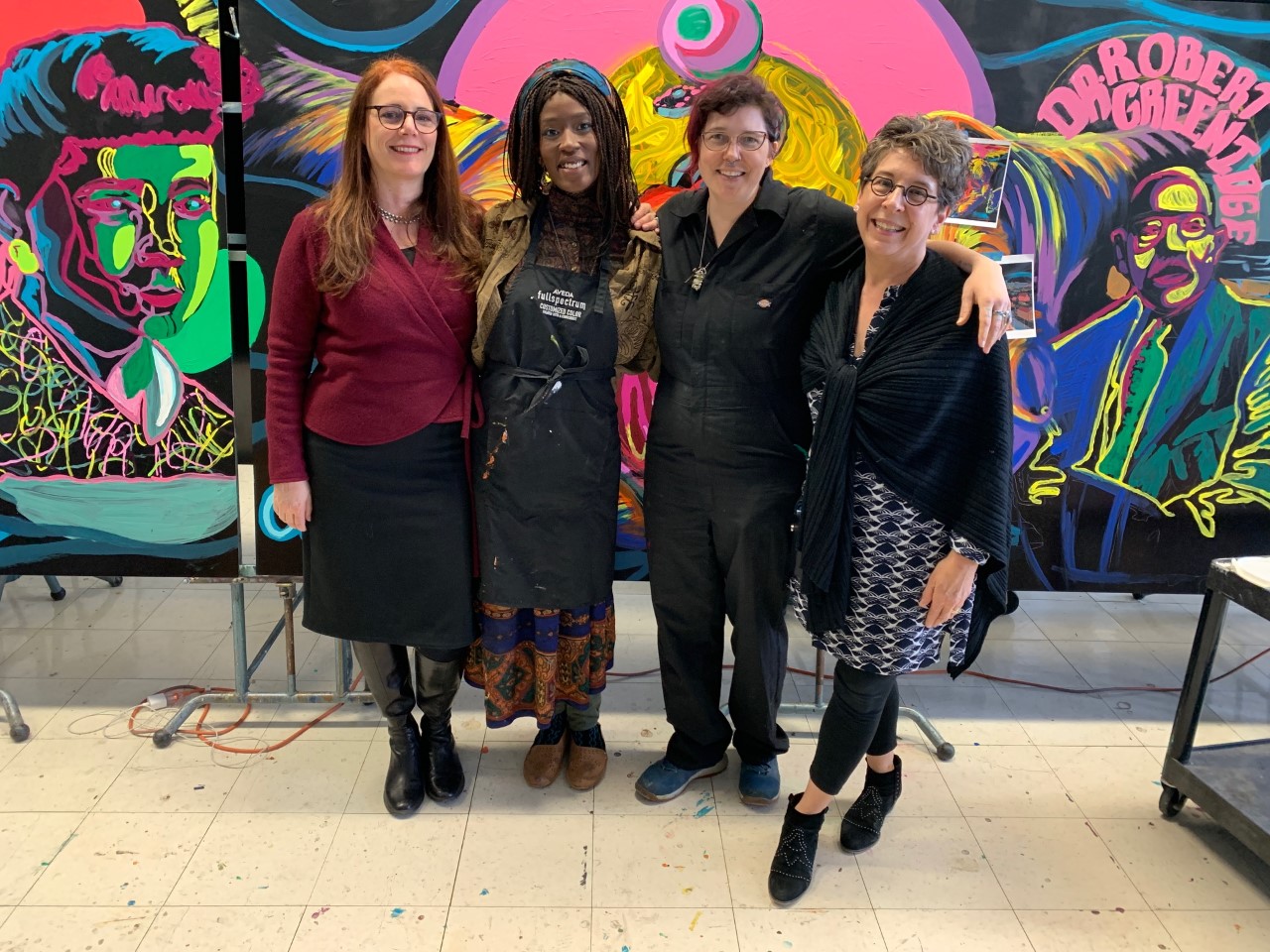 In addition to recognizing the legacy and history that the mural will showcase, Dr. Sood feels strongly about the positive effects that the arts can have for the medical community today.
In addition to recognizing the legacy and history that the mural will showcase, Dr. Sood feels strongly about the positive effects that the arts can have for the medical community today.
“As a physician, the most important aspect of this collaboration for me is to cultivate that creative aspect of our beings that is often neglected in medicine. We are so focused on memorizing so many diseases and so many facts, we forget the humanitarian aspect and we forget the wellness aspect.”
The stress of the pandemic has had a deleterious effect on those working on the frontlines of the health care system during times of scarcity and increasing burden of disease. “Physician mental health has been especially impacted because they have had to make decisions about who to provide support to and who to deny ventilators, and also having to isolate at work and at home,” Dr. Sood said. “We saw a marked increase in physician suicide because of the hard decisions that they had to make. Patients, their families and physicians have suffered with so much pain. How do we use arts as a means of healing and a path to wellness for both the caregiver and for the patient? There are a lot of dimensions to this.”
As artists and educators, a driving motivation for both Fae and Young is the positive impact of art for healing individuals and communities.
“This work is for the people of Detroit and also for the people in the medical community, which is especially important right now,” Fae said. “This is something we as artists can do to honor the medical community that has literally impacted the life of every single person in a very direct way.”
“Though art making we are documenting social conditions but also impacting them,” Young added. “We are reminding Detroiters that they are loved and that we haven’t forgotten about historic places like Black Bottom, and that we are still keeping the spirit of Detroit alive.”
In commemorating these dimensions of Detroit’s history through the mural, history is also being made for the department and for WSU.
“I think that people will really pay attention to this project,” Serra said. “This process has been a celebration of how students from different disciplines are working together on campus and getting real life experience.”
Young added, “Projects like the mural show that voices can be heard and communities can be uplifted through art-making. People will see this, and it is more than just painting. It’s history.”
After the mural is installed outside of Scott Hall on June 13 (weather permitting), a mini-documentary about the project will be released this summer.
Courtesy of Siobhan Gregory, WSU associate professor of Art and Art History